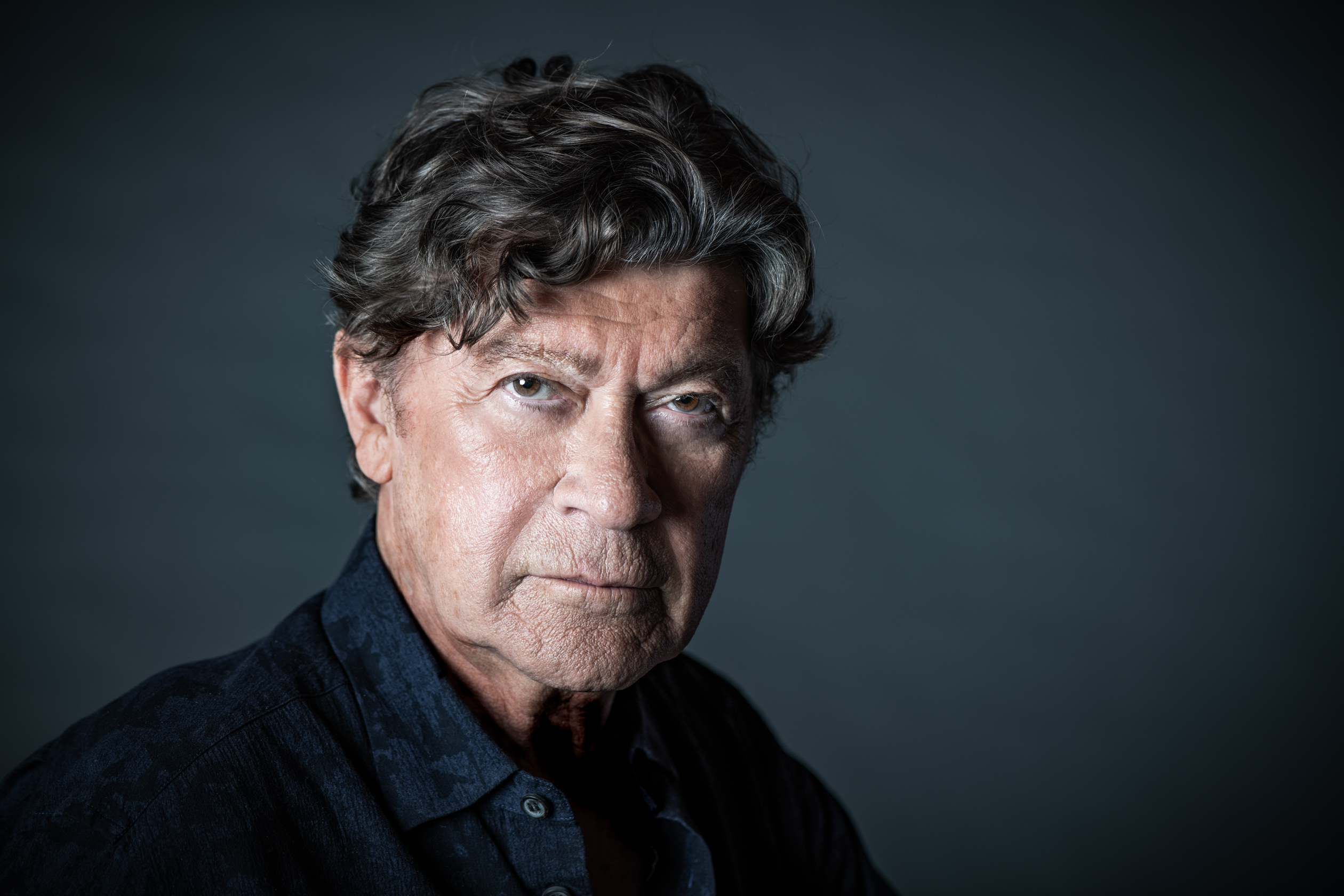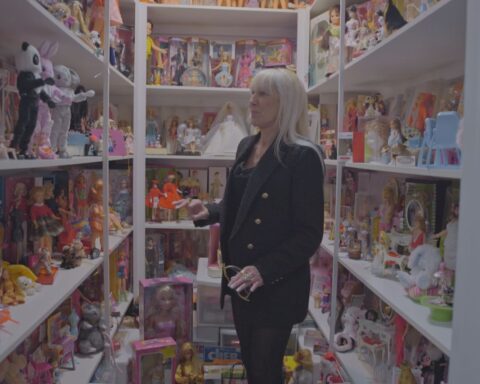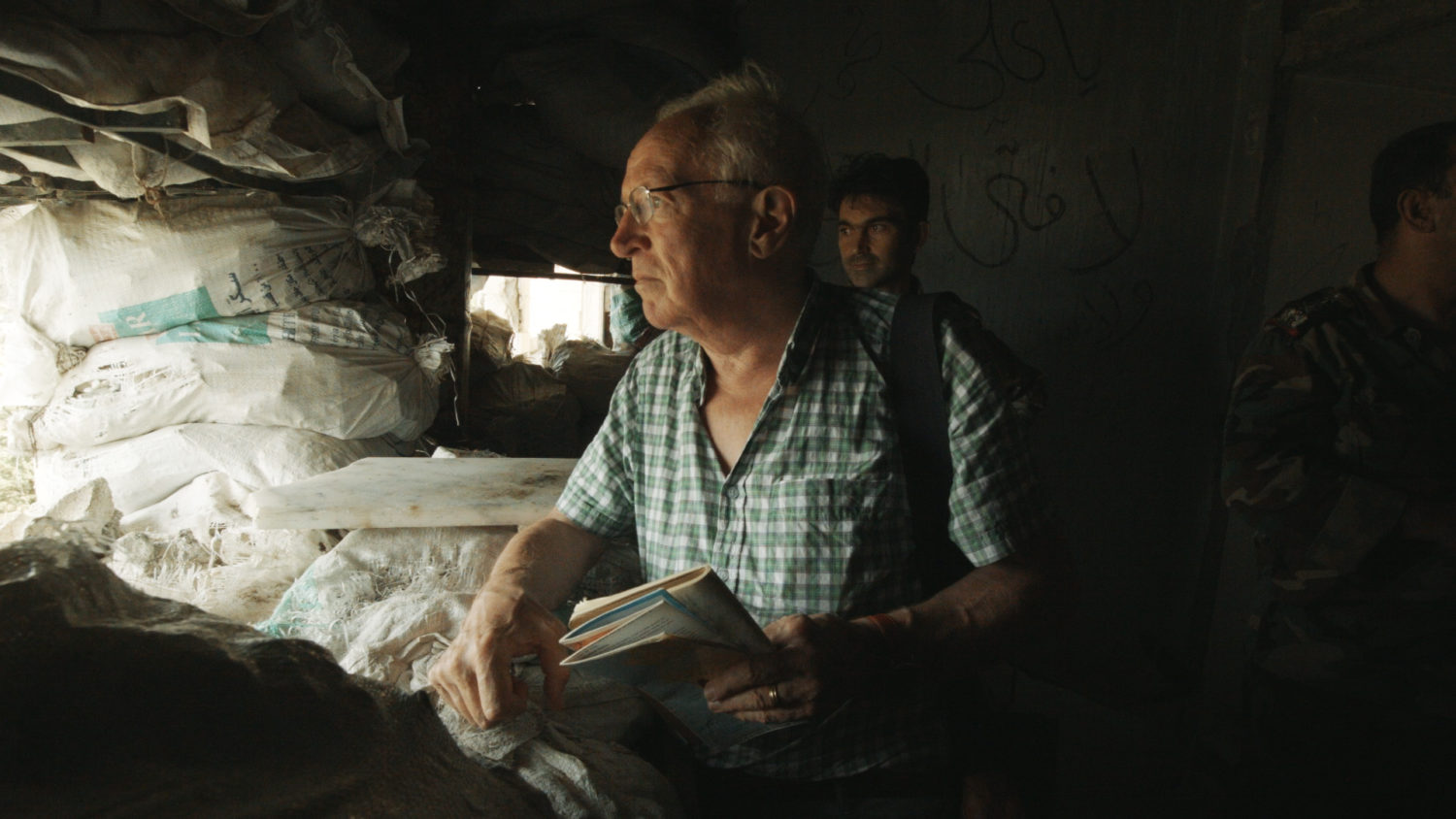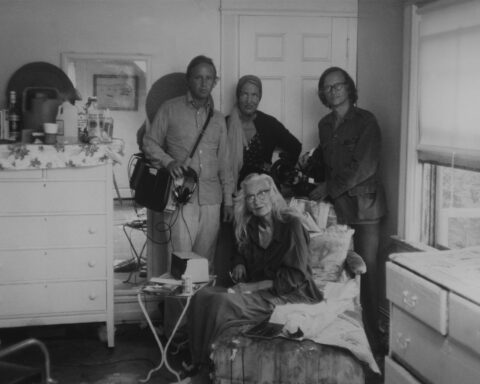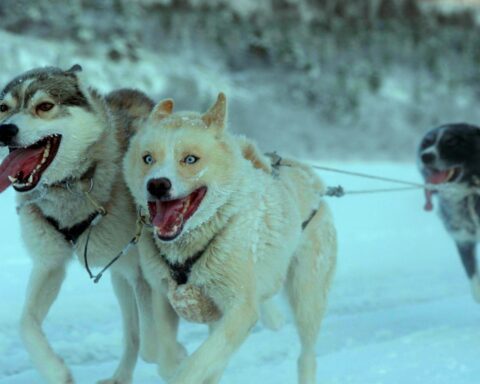Some stories have a beginning, a middle, and no end. Instead, they get passed on and grow in new places. One of those stories is about a sixteen-year-old boy, in 1960, crossing the U.S.–Canada border almost a thousand miles north of the Mississippi Delta and traveling down to Arkansas to join up with a rockabilly band.
You might recognize this as the start of the tale of Robbie Robertson and the Band, the four-fifths Canadian group, which started out by backing up Toronto-based singer Ronnie Hawkins, performed with Bob Dylan on his legendary 1966 tour, and then began releasing their own records: carefully crafted music full of joy and reverence, which shifted the bedrock of mid-century popular music, opening up its wellsprings in folk, blues, honkytonk, gospel and bluegrass.
Now, almost sixty years after that train ride, Robertson’s story has risen again in a new documentary, Once Were Brothers: Robbie Robertson and the Band, which opens this year’s Toronto International Film Festival (TIFF). Produced by Toronto’s White Pine Pictures, the film traces Robertson’s story with hundreds of archival photos and film clips alongside interviews with a pantheon of rock heroes—Bob Dylan, Bruce Springsteen, Van Morrison, Eric Clapton. The A-plus guestlist for the September 5 TIFF premiere includes executive producers Martin Scorsese, Ron Howard and Brian Grazer.
All of this represents a consequential moment for Peter Raymont, founder of Toronto-based White Pine, the boutique production company which celebrates its fortieth anniversary this year. “We’re just really proud of this film,” he says. “It’s a great Canadian story. I’m sure it will be picked up by a big theatrical distributor and everyone will see it.”
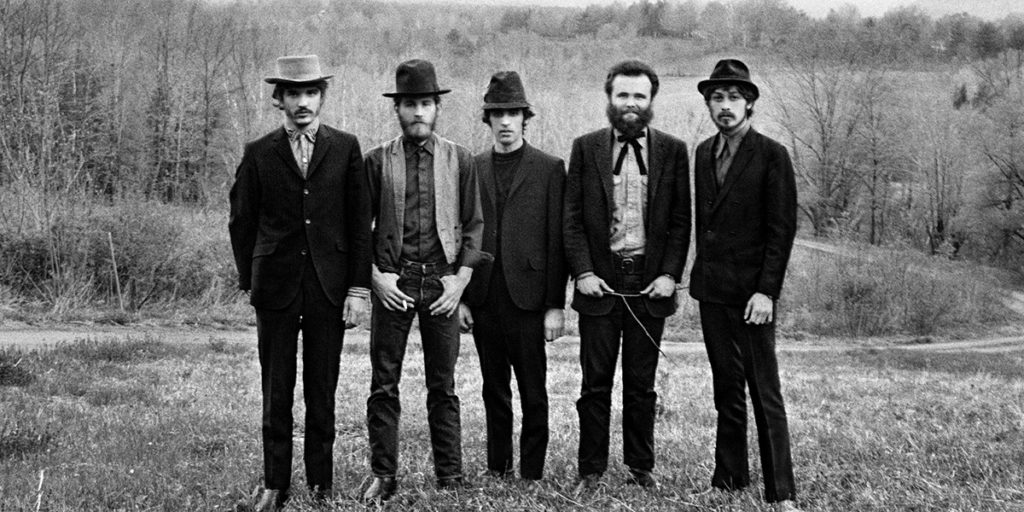
Perhaps the continuity of that long ride in 1960 shouldn’t be a surprise. Jaime Royal (Robbie) Robertson, who spent his summers with his mother’s relatives on the Six Nations of the Grand River reserve near Brantford, Ontario, was primed for myth-making. When he heard traditional stories from community elders, he told his mother he wanted to be a storyteller too. In rural Arkansas, he found in the Southern culture the raw material—images, characters and sounds—that shaped his music. “To my ears, this was poetry come to life,” he once wrote.
Acolytes of the Band know the stages of the group’s progress like good Catholics know the stations of the cross. In 1963, Robertson and his bandmates—the mischievous innocent Rick Danko, sonic keyboard wizard Garth Hudson, soulful singer Richard Manuel and booty-shaking, raspy-voiced Arkansas-native drummer Levon Helm—split from their mentor Ronnie Hawkins. After providing the electricity behind Bob Dylan on a world tour, they settled near Woodstock, New York, in a tacky pink house, to compose music.
Over the next decade, the Band released seven studio albums, two with Dylan and two live records, Rock of Ages and The Last Waltz, the latter the soundtrack to a farewell concert film at San Francisco’s Winterland Ballroom, directed by Martin Scorsese. The concert, featuring the Band’s favourite musician friends—Muddy Waters, Dylan, Joni Mitchell, Van Morrison, Eric Clapton, Neil Young—was less a fly-on the-wall documentary than a constructed romantic fantasy, shot in 35mm in front of chandeliers used in Gone with the Wind. Pauline Kael declared it the most beautiful rock movie ever made. Forty years later, that assessment still holds up.
Robertson’s departure from the Band and his repudiation of what he called “this goddam impossible way of life” took place more than four decades ago. He has continued working with Scorsese, finding songs and scoring music to more than a half-dozen of the director’s films; done A&R for DreamWorks; and released records focusing on North American Indigenous music as well as several solo albums With a slew of lifetime achievement awards, he’s a venerated figure, far from the grimy bars and motels of his youth.
In 2010, Robertson was at the Nantucket getaway of Indigo Books CEO Heather Reisman when another literary guest, Louise Dennys of Random House, listened to his stories and told him he should write a book. The result, released in 2016, was Testimony: A Memoir, a 500-page collection of familiar and fresh tales ranging from Robertson’s childhood to The Last Waltz.
His stories, many repeated in the film, are sometimes funny, sometimes harrowing, but mostly sunny: a portrait of a man who fulfilled his adolescent dreams and consistently found himself in the most interesting places at the right time.
Several film companies made pitches to get the film rights. Andrew Munger, White Pine’s head of documentary development, immediately bought the book, read it and passed it on to the company’s president, Peter Raymont. They made a successful pitch to get the book rights through Robertson’s manger, Jared Levine.
Robertson provided a storage locker full of personal material, and Bob Dylan’s archives added a mountain more, but music and film rights were going to be expensive and partners were needed. Bell Media provided seed money with a broadcast license and brought on Universal Music Canada’s ad-agency partner, Shed Creative. Later, they were joined by Ron Howard and Brian Grazer’s Imagine Entertainment, the company behind the recent music documentary hits The Beatles: Eight Days a Week and Pavarotti.
White Pine found a director, who shot some useful footage but didn’t have the right chemistry with the Robertson team. Eventually, they decided to take a chance on a young newcomer, Daniel Roher (pronounced “roar”), a twenty-six-year-old with no feature credits but an unusual pitch: “I will die before I make a bad movie about the Band.”
“He was pretty passionate,” laughs Raymont. ”He’d read Robbie’s book cover to cover many times and underlined passages. He begged me to let him meet Robbie so I got him in touch with Jared [Levine]. I guess Daniel impressed Jared, who let him meet Robbie.”
Soon after, Raymont received a call from Robertson: “Hey, Peter. We got to hire this kid Danny. He reminds me of me when I was his age. He’s not very experienced but I’m sure you’ll surround him with good people.”
Roher, who is tall with glasses and a scruff of beard, looks a little like a young Robbie Robertson, which probably pleases both of them. He came to this story not by train, but by canoe: “This sounds so cliché Canadiana. We were on a family canoe trip in Algonquin Park, winding down this little creek and my dad’s paddling and singing ‘Up on Cripple Creek.’”
He became a Band head, even creating a graphic novel treatment of “The Night They Drove Old Dixie Down” as a high school art project. Later, he dropped out of art college and made a bunch of short documentaries (earning a couple of Canadian Screen Award nominations) but, prior to Once Were Brothers, had never shot a feature film. “I was just a hair above the minimum I needed to try for this job,” he says.
Possibly, he also seemed a couple of generations too young to be an expert on the Band’s music—though, in fact, he is: “The music was always so evocative to me of another place and time. It was akin to looking at a Matthew Brady photograph from the Civil War. The songs transported me. I suppose I should have been listening to Nelly Furtado or Avril Lavigne, fine Canadian artists of my generation, but the Band was the soundtrack to my life.” (As it happens, Robbie Robertson, in his role as a DreamWorks Records A&R executive, signed Nelly Furtado to her first record contract.)
“When I met Robbie, I knew I may not have been the most obvious choice to make this movie, but one of the things I think that was compelling was that I put a mirror up to him, whether I intended to or not. This film is ultimately about a highly ambitious man who is trying to make his mark in the world in the art form he was born to do. I know what that’s like.”
I was curious about the man on the other side of that mirror, about how Robertson felt about entrusting his stories to someone half a century his junior.
“You just have a gut feeling,” says Robertson, on the phone from his Los Angeles office. “When I met with Daniel, he reminded me of that youthful spirit of someone who is really on a mission, is going to reach deep and is a tremendous, dedicated soul. I said, ‘This is the guy I’d like to work with,’ and the people who were going to produce it—White Pine, Shed and then Imagine Entertainment—met him and said, ‘Okay, we get it. We know what you’re feeling here.’”
Did it surprise Robbie Robertson that someone as young as Daniel would follow the Band’s music so avidly? “I’m very grateful that this music that I’ve made over the years has had a lasting impression, has been influential,” replies Robertson. “I think part of that comes from an appreciation of mine on what music does to people. Music can have a timeless quality. That meant much more to me than a popularity contest.”

Roher has a take on the Band’s story: “Robbie and his four best friends released records that became enshrined in history. But they were five fragile men, who were suffering from insecurities and anxieties. That’s what I gravitated toward, the fragility of brotherhood.”
Almost every rock band biography starts out with a team of heroes like Jason and the Argonauts and ends up like Cain and Abel. The Band, alas, was no exception. Part of Once Were Brothers shows how Robertson extricated himself from a band who, playing chicken with their lives, had sunk into heavy drug and alcohol abuse.
In 1986, Richard Manuel, struggling with alcoholism, hanged himself at forty-two in a Florida motel room. In 1999, Rick Danko, who struggled with heroin and alcohol for decades, died of a heart attack, just short of his fifty-sixth birthday. Levon Helm and Garth Hudson went bankrupt. Yet they had post-Band successes as well: Manuel collaborated with Hudson, Willie Nelson, Bonnie Raitt and other musicians on record sessions. Garth Hudson formed his own band and remains in demand as a session player. Between 2007 and 2010, Helm’s records won three Grammy Awards, including one for the inaugural Best Album for Americana, a genre the Band virtually invented. To quote Orson Welles, “If you want a happy ending, that depends, of course, on where you stop your story.”
While he never went broke, Robertson took some tough hits to his reputation. In a 1993 book, This Wheel’s On Fire: Levon Helm and the Story of the Band, Helm accused Robertson of destroying the Band, conspiring with record company executives to steal song credits, and, with Scorsese’s help, using The Last Waltz to portray himself as the band’s maestro. The narrative that saw Robertson as villain persists in Internet comment sections and blogs, though often its strongest advocates don’t seem to grasp the copyright law that says that, as the Band’s principal songwriter, Robertson stood to benefit the most from keeping the group together.
“Of course, I wanted to get to the bottom of the feud,” says Roher. “But what happened between those guys, I wasn’t there for. Nobody was taking notes. But you talk to six people who were there and they all say the same thing [as Robertson] and you can’t ignore it. A feud implies people are fighting each other. It seemed to me that Robbie really only had love for Levon. It’s taken over the Band’s legacy a bit but when I’m playing this music for my grandchildren, I’m not going to be talking about some fake feud.” Robertson held his tongue. He visited Helm on his deathbed in 2012, and praised his old bandmate as “one of the most extraordinarily talented people I’ve ever known and very much like an older brother to me.”
I tell him I find his explanations of the rift in the book and film credible and generous. Where did he think things went wrong?
“I recognized this was something in Levon’s nature,” says Robertson. “It had become more exaggerated over time. I wasn’t sure what it was due to but, in those later years, there was nothing for me to respond to, really. I just felt bad. I have such a deep appreciation and love of the times he and I spent together, I couldn’t find a way to piss on that. So, I turned my back. I just said, ‘That’s ridiculous. I’ve got to do what I’m doing.’ It was a one-man sword fight.”
Robertson is, when the inclination strikes, writing the second part of his memoir. He refuses to end our interview on a sad note and toward the end of our conversation, the key shifted from minor to major. As a pitchman, he makes even Danny Roher sounds like an apprentice.
“I’m on a mission of discovery,” he says. “Wait till you hear my new record and what I’ve been doing. It comes out around the same time as the Toronto International Film Festival and it’s called Sinematic — like “cinema” but with an “S.” It’s one of the most interesting things I’ve ever done, is how I’m feeling about it. I’m thrilled with that.
“I’m also really excited about the score for The Irishman, which I’m doing for Martin Scorsese. And now we’ve got this documentary. They all blend together ’cause I’m working on them all at the same time. And it’s the fiftieth anniversary of the album The Band. I can’t separate them and they’re all bleeding into one another and I am loving it.”
He pauses to let that sink in. I say the only thing I can when I see anyone singing along his chosen road: “I’m happy for you.”




